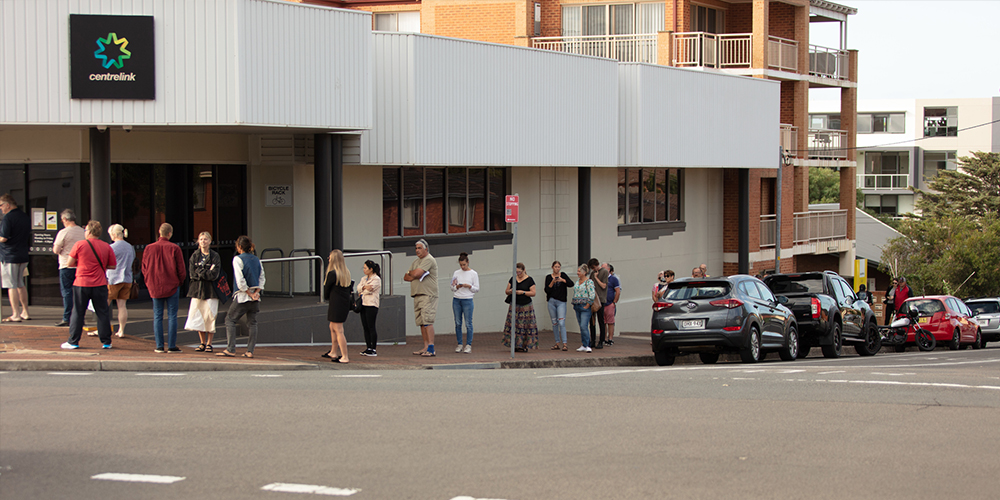Australians have become used to disruption and its impact on employment. Over the past decades, film has been replaced by digital cameras and photographs, we use email and instant messaging instead of letters, while online purchasing has increased dramatically at the expense of retail stores. We now use Uber instead of taxis and Airbnb instead of hotels. But no one predicted the major disruption to employment that has resulted from the coronavirus (COVID-19) pandemic.
The COVID-19 pandemic created unprecedented queues outside Centrelink offices reminiscent of the Depression of the 1930s. The predominately female-dominated industries of tourism, hospitality, sport, retail, entertainment, and beauty and lifestyle services have been particularly affected. The elderly in our society who lived through the Second World War have commented on the similarities in our response to this current threat. They have referred to the shortage of some products, and uncertainty about the future. But in some ways, the COVID-19 pandemic is worse than war.
Features of war and the Depression
During war, most of the population is concerned about the welfare of those who have enlisted into the armed services and gone to fight. They have to cope with the uncertainty of their friends and relatives wellbeing and safety, and this has usually been a source of constant fear and anxiety. But the general Australian population remained at home, and would not have had the same fears for their own personal safety. Unlike the Depression of the 1930s, during war there would not have been a shortage of opportunities to work towards the war effort.
The COVID-19 pandemic has many of the worst features of both war and the Depression. The general Australian population has experienced a fear of contracting and dying from an unseen, invisible, highly contagious external enemy stealthily infiltrating our community. For many Australians, fear about their own safety and survival has increased. This coupled with the sudden, unheralded loss of employment and loss of income, threatens their ability to ensure shelter and food for themselves and their families. Maslow’s hierarchy of needs has been discovered, or rediscovered.
Another issue that has arisen that is different from both war and the Depression is the government imposed social and physical isolation restrictions. This form of social isolation has impacted on children interacting with their friends, parents connecting with their siblings and parents, and grandparents interacting with their grandchildren. People have been restricted from visiting the elderly in aged care facilities and there have been minimal numbers permitted at births, weddings and funerals.
A framework for responding
But there have been some positives. The rollout of high-speed internet over the past few years has provided the opportunity to use videoconferencing and maintain contact with those we love and those with whom we work. This option was not available to previous generations and has allowed working from home to be a viable plan for many individuals, particularly for those who work in administrative roles. The availability of modern information technology and smartphones has allowed us to keep up-to-date with news and the latest developments on the pandemic. It has facilitated the exchange of information, both nationally and internationally, and provided a level of collaboration between researchers in the efforts to find a treatment or a vaccine.
Australia has been fortunate to have in place an excellent public health capability and infrastructure. Our island continent has provided the ability to isolate Australia from the rest of the world, and therefore reduce the influx of new infections. The national response to combat this pandemic has been extremely well-managed and implemented with an almost united response, with little tendency to play politics.
In general, there has been responsible media reporting and avoidance of sensationalism. We may come out of this pandemic with significant suppression, or even the possibility of elimination, of COVID-19. We may have a low level of COVID-19-related illness in our community and minimal loss of lives, compared to many other countries.
Weighing the costs of COVID-19
But at what cost has this been achieved? We need to consider those at the frontline of the pandemic such as healthcare personnel assessing and treating potentially or actually infected patients with COVID-19. There are others in essential roles such as supermarkets, service industries and the emergency services, as well as those maintaining essential logistics support. These are the modern warriors of this war.
We already note the mental effects of war on our military personnel who put their own lives at risk in their dedication to carry out their duties. They do this because of the confidence in their skills and training, and understanding the essential purpose of their role is for the benefit of others. We recognise that military personnel develop mental health consequences from the devotion to duty. They experience chronic fear and anxiety from the personal risk to their health or risk of death. This is accentuated as they see their colleagues falling or dying around them.

We need to recognise there are similarities affecting healthcare workers facing this invisible enemy. The shortage of personal protective equipment increases their fears of contracting COVID-19, and passing it on to their families. What if individuals become infected themselves? How will the hospitals cope if they are overrun with infected patients? How will they manage and cope with the ethical decisions if there are resource limitations? How will they cope with the increasing numbers of infected people seeking care each day if there becomes a shortage of health care workers? So the emotional response amongst healthcare workers and others at the front line providing essential services, is significantly greater when compared to other emergencies that increase the demand on health and other critical services.
These responses are exacerbated when these essential workers have been abused and spat upon both inside and outside of the work environment. Anxiety is increased because of the uncertainty about how long this pandemic will last. There is also a fear among those who work with vulnerable populations such as Indigenous populations, the disabled and the elderly in aged care facilities.
At the time of writing this article, the level of community transmission of the pandemic is lower than expected. This validates the decisions to restrict entry into Australia and prohibition of international travel, the importance of cough hygiene and handwashing, and the importance of social and physical distancing to prevent the spread of this virus. It is likely that there will continue to be small clusters and outbreaks as it appears to be almost impossible to eliminate this infection from the community.
It has been difficult for people who have lost their jobs, need to remain at home, provide supervision and home education to deal with these increased anxieties and fears. It is reassuring to note that the mental health impacts of this pandemic have been recognised and highlighted throughout the response. There is acknowledgement that there needs to be an increase in resourcing for mental health services as we respond to and come out of this pandemic.

Managing the fallout
But there is another concern which has not yet been appreciated or acknowledged. There will be a large increase in both mental and physical illness that will arise from the social isolation and the reduction in employment from this pandemic. This is more than will arise from the obvious stress, and the increase in consumption of alcohol and rates of domestic violence that have already been reported. This increase in illness will arise from the extent of both unemployment and underemployment, which will continue over the coming months and probably years and will predominantly affect women.
The World Health Organization recognises that there are social determinants of health other than lifestyle. Employment is one of the most important factors that contributes to improving health and wellbeing. Most individuals will adapt and respond quite well to the way the world has changed in response to this pandemic. But there will be a percentage of people for whom their health will become worse and they will need ongoing mental health services. Many of these people will find it difficult to engage with others because of their distress. These individuals may seek to continue on government benefits or apply for disability pensions.
Although it is tempting to support such requests, this may be creating more harm. The evidence has accumulated over the last decade that ‘good’ employment is one of the most beneficial factors to manage people with anxiety and depression. Encouraging return to work, or engaging in work, is one of the most important treatments we can offer these people who are distressed. The evidence is strong that returning to work reduces the number of episodes of depression, as well as reducing the severity of depression (van der Noordt, IJzelenberg, Droomers, & Proper, 2014).
Even those experiencing work limitations have improved occupational and psychiatric outcomes if they are helped to identify barriers to functioning and to adopt new work-focused cognitive-behavioural and work-modification strategies by the implementation of work-focused interventions in addition to integrated care (Lerner, Adler, Rogers, Ingram, & Oslin, 2020).
What else can be done?
Of course, there is likely to remain a shortage of jobs and opportunities for employment. Reskilling and retraining to assist in gaining employment for the post-pandemic world should be a priority for governments. The Commonwealth Employment Service established in 1946 provides an example of a successful model. Those who are unable to find work should be encouraged to become actively engaged in activities such as voluntary organisations, community activities, sporting clubs, Men’s Sheds, church groups or choirs. All these things help people regain meaning in their life, improve their self-respect and self-esteem and reduce the potential for mental health problems.
Encouraging employment or active community engagement is important as there is now evidence accumulating that mental illness is often followed a decade or so later by physical illness (Momen et al., 2020). The Australian Psychological Society is a signatory to the Royal Australasian College of Physicians Consensus Statement on the Health Benefits of Good Work (bit.ly/2X8CYMb). Never has there been a more important time in our community to promote good work as a way of maintaining good health.
The author can be contacted at [email protected]